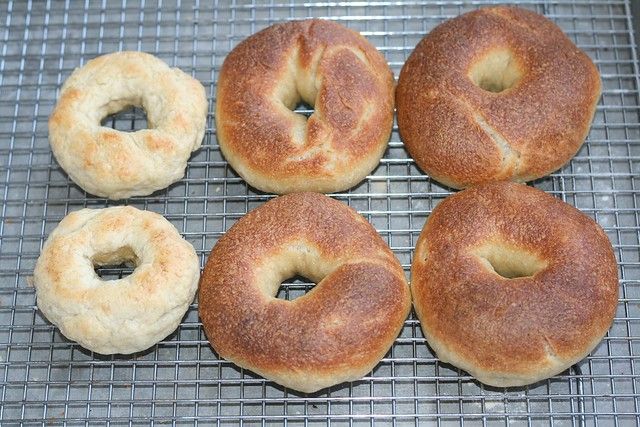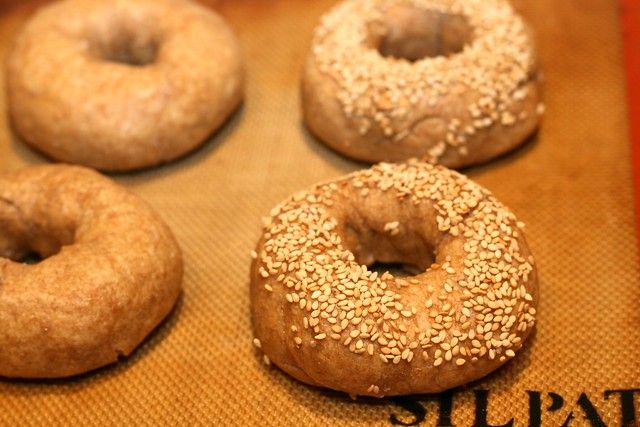Whole Wheat Sourdough Bagels
I love me some bagels. I grew up in New York where I acquired a taste for warm, chewy bagels. Especially when they are loaded with cream cheese and topped with lox and capers.

I love me some bagels. I grew up in New York where I acquired a taste for warm, chewy bagels. Especially when they are loaded with cream cheese and topped with lox and capers.
That said, I really don’t like the bagels you can buy in the store. Most bagels are made with white flour and commercial yeast. I’ll be blunt: they make me gassy. And they are not nutritious.
Sometimes I will buy the sprouted bagels you can find at Trader Joe’s or Whole Foods. They’re not bad and they are healthy. But they’re just not very fresh. Even when toasted, they taste dry and crumbly. It’s not their fault. Bagels should be fresh, eaten the same day they are baked.
The solution? Make my own bagels.

I was always afraid to try because I thought it would be hard. When I finally attempted it, I was surprised at how easy it is to make delicious whole wheat sourdough bagels at home.

Online Cooking Class: Healthy Whole Grains
I teach this recipe for Whole Wheat Sourdough Bagels in my online cooking class, Healthy Whole Grains.
Sign up now for only $199
Click here to sign up now!
Recipe Notes
This recipe is adapted from a recipe in Classic Sourdoughs, Revised: A Home Baker’s Handbook by Ed and Jean Wood.
Bagels require a lot of gluten in order to rise. For this reason, I suggest using half all-purpose unbleached white flour.
If you don’t want to use white flour, you can also use vital wheat gluten. You want to use around 1 TBS wheat gluten per cup of whole wheat flour. If you are using half white flour, you don’t need to use any vital wheat gluten.
Also: your sourdough starter should be very active. It should look like a doughy version of Champagne. Please see my post on Sourdough Bread to learn how to activate a sourdough starter.
If you like, you can shape the bagels the day or night before and let them sit in the fridge overnight and make your bagels in the morning for breakfast. You can also freeze the dough rings for up to three weeks. Just thaw overnight in the refrigerator. Whether you refrigerate or freeze, make sure you bring the dough up to room temperature before you boil the bagels.
Why Boil Bagels?
Boiling gelatinizes the starch in the outer layer of the dough, giving the bagels their chewy crust. I added 2 TBS of sugar to the water to sweeten it which adds to the bagels’ flavor.
Watch Out for Overproofing!

Overproofing can ruin your sourdough bagels. In the photo above, the bagels on the left were overproofed (they were also shaped too small).
My kitchen is very warm: 75-80 degrees, without running the heater! (We’re on the 4th floor.) I realized that my warm kitchen was causing my bagels to overproof. They looked and felt like rocks.
The next time I made bagels, I moved the bowl of dough to our guest room and set it on a chair next to an open window. I bought an indoor thermometer to make sure the temperature stayed around 70 degrees F (it fluctuated between 68-72). I used the exact same recipe but this time the bagels came out perfect.

Whole Wheat Sourdough Bagels
Makes about 10 bagels
Ingredients
Active sourdough starter (2 cups or 480 ml)
Eggs, pastured or free-range organic (2)
Coconut oil, melted, or olive oil (2 TBS)
Milk, whole, raw, organic (1/2 cup or 120 ml)
Sea salt (1 tsp)
Coconut sugar or sucanat (4 TBS, or 50 g, divided)
Whole wheat flour, freshly ground if possible (1 1/2 cups or 210 grams)
All-purpose unbleached flour (1 1/2 cups or 210 grams)
Optional: Butter or coconut oil for the baking sheets or grass fed butter
Filtered water
Equipment
Indoor thermometer
Optional: Dough Whisk
Plastic wrap
Dutch oven or heavy bottomed pot
Baking sheet
Optional: Silpat Baking Mats
Directions
1. Place the active sourdough starter in a mixing bowl.
2. With a wooden spoon or dough whisk, stir in the eggs, oil, milk, sea salt, and 2 TBS of the sugar.
3. Add the flour one cup at a time. If you are using freshly ground flour, you may choose to sift a little of the bran out for lighter baked goods (I usually sift some but not all of it out).
4. When most of the flour is incorporated, transfer the dough to a floured board or counter top. Knead with floured hands for 5-10 minutes, adding more flour to keep it from sticking.
5. Transfer the ball of dough to a large bowl covered with plastic wrap. Lit sit (proof) for 8-12 hours at 70 degrees F (21 C). The dough should double in size. Be careful not to proof too long and if your house is too hot, make sure you cool it down to around 70 degrees (see information about overproofing above).
6. After the dough has risen, divide it into 10 equal pieces (you can weigh them on a digital scale).
7. Form the pieces of dough into balls.
8. Cover the balls of dough with a damp cloth and allow them to rest for 5-10 minutes.
9. While the dough is resting, bring 3 to 4 quarts of filtered water to boil in a large Dutch oven or other pot. Add 2 TBS of coconut sugar or sucanat.
10. Preheat the oven to 500 degrees F (260 degrees C).
11. Grease two baking sheets or line them with Silpat Baking Mats.
12. Press one of the dough balls with the palm of your hand. Find the center and push a finger through to make a hole.
13. Swing the dough around your finger to widen the hole. The dough circle should be around 1-inch thick and the hole around 2 inches wide. Don’t worry if the hole seems too large: it will close up as the bagel boils and bakes. After each bagel is shaped, put it back underneath the moist towel.
14. Drop two or three of the bagels into the boiling water. Don’t overcrowd the bagels, otherwise the water will get too cool.
15. Boil the bagels for 1 to 2 minutes — until they have expanded in size.
16. Turn them with a slotted spoon or spatula. Let them boil for another 1 to 2 minutes.
17. Remove each bagel from the boiling water. The bagels will have puffed up and the centers will be almost closed.
18. At this point you can add poppy seeds, sesame seeds, or whatever toppings you like. Put the seeds on plates and then dip the the tops and sides of the bagels into the seeds.
19. Arrange the seeded bagels on the greased baking sheets or Silpats.
20. Bake the bagels in preheated oven for 10 minutes. After 10 minutes, check the bagels and loosen them from the baking sheet with a spatula (most likely they won’t sick but check just in case). Then bake for 5 more minutes for a total of 15 minutes.
21. Transfer them on a rack to cool.




Comments ()